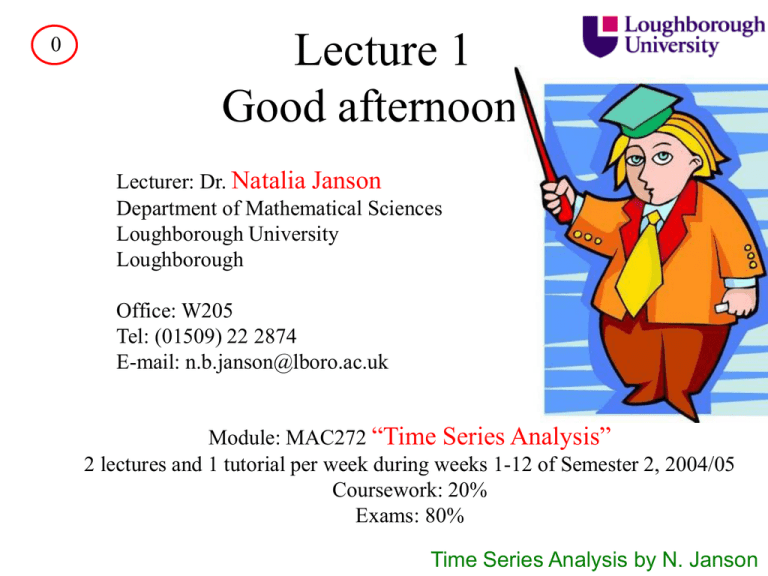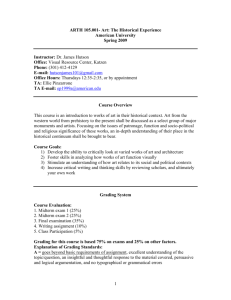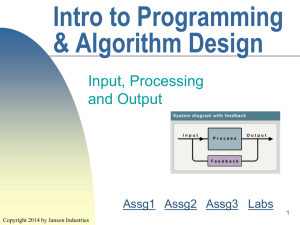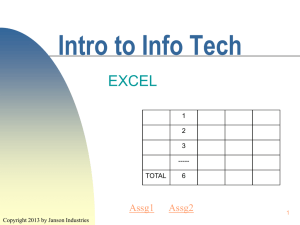PowerPoint Presentation - Time Series Analysis
advertisement

0 Lecture 1 Good afternoon! Lecturer: Dr. Natalia Janson Department of Mathematical Sciences Loughborough University Loughborough Office: W205 Tel: (01509) 22 2874 E-mail: n.b.janson@lboro.ac.uk Module: MAC272 “Time Series Analysis” 2 lectures and 1 tutorial per week during weeks 1-12 of Semester 2, 2004/05 Coursework: 20% Exams: 80% Time Series Analysis by N. Janson Time Series Analysis 1 Lecture 1: Introduction 1. 2. 3. 4. Processes, state variables Signals and their examples Time series: definition Aims of Time Series Analysis Time Series Analysis by N. Janson What do we study? Whatever is going on around us are processes occurring in certain systems. Some obvious examples are: 2 •the change of weather (system: Earth atmospehere) •the change of illumination during the day (system: Earth atmospehere) •the daily change in exchange rates (system: financial market) •the change in monthly amount of beer drunk by a certain person (system: person) In lay terms: process is the change in time of the state of the system. Note: the state of the same system can be characterized by one or several variables. Examples: •weather at the current moment can be characterized by air temperature, humidity, wind velocity, atmosphere pressure, etc. •state of the person can be characterized by his/her body temperature, average heart rate, average respiration frequency, blood pressure, appetite, etc. One may record and observe the change in time of several, or of just one variable characterizing the system state. The recorded dependence of some variable in time is also called a realization. Time Series Analysis by N. Janson Marketing example: wine sales of a certain company 3 System: company State variable: monthly wine sales months Data are taken from http://home.vicnet.net.au/~norca/Red_Wine.htm Time Series Analysis by N. Janson A medical example: Human Electrocardiogramme (ECG) 4 voltage System: cardiovascular system of a human Process: heart beats State variable: voltage between two points on the human body. ~ 1 sec time Measures electrical activity of a human heart. Time Series Analysis by N. Janson A biological example: position of a point on the surface of Isolated Frog’s Heart 5 coordinate System: frog’s heart State variable: position of a point on its surface position of this point is recorded time Time Series Analysis by N. Janson A mechanical example 6 System: mechanical system State variable: position of the load Time Series Analysis by N. Janson System, Process and Signal 7 State variable 1 Signals System State variable 2 Time Series Analysis by N. Janson Time Series 8 Time series: a collection of observations of state variables made sequentially in time. Univariate (bivariate, multivariate) time series: collection of observations of one (two, several) state variables, each made at sequential time moments. Note: the order of observations is important! Notations •continuous signal a(t) •time series a(ti)=a(iDt)=ai, i=1,2,…,L •sampling step Dt •length of time series L •sampling frequency fs=1/Dt Synonims: •Time series, (experimental) data, sampled signal, discretized signal •Sampling rate (step), discretization rate (step) •Time Series Analysis, Data Analysis, Signal Processing, Data Processing Remark: Mathematically, “time series” is not a SERIES, but a SEQUENCE! Time Series Analysis by N. Janson 9 Pressure, au Example of time series: blood pressure of a rat Time Series Analysis by N. Janson Aims of Time Series Analysis 10 1. Description Describe (characterize) a generating process using its time series. 2. Explanation If time series is bi- or multi-variate, then it may be possible to use variations in one variable to explain the variations in another variable. 3. Prediction (forecasting) Use the knowledge of the past of the time series to predict its future. 4. Control To change deliberately the properties of the process by influencing it and observing the changes introduced by our intervention. One can then learn to make the needed effort to achive control. Time Series Analysis by N. Janson Example of description 11 Assume the time series shows the tendency to repeat itself with some accuracy. ECG shows a sign of periodicity. Then one can assume that the process is inherently rhythmic, and can estimate the average or most probable rhythm in it. The average rhythm of heartbeats can be estimated from estimating the rhythm of ECG. For information: Average heart rate of a healthy Human is ~ 1 sec. Time Series Analysis by N. Janson 12 Example of explanation Three signals are measured from the same ill human simultaneously: Electrocardiogramme (ECG), pressure, respiration. Floating of average level of ECG and especially of pressure are caused by breathing. Time Series Analysis by N. Janson Example of prediction 13 Weather forecast A lot of experimental data are measured during a certain time interval. The data are being analysed, the tendencies are being revealed. From what is available by the current moment the future weather is predicted. Time Series Analysis by N. Janson Example of control 1 14 Balancing a tray. Time Series Analysis by N. Janson Example of control 2 15 A sailing boat is being navigated in windy weather. It needs to go in the particular direction, and this direction is governed by the angle between the wind and the sail. The wind is occasionally changing its direction. The sailor needs to adjust the angle between the sail and the wind in such a way that the direction of motion is kept as constant as possible. System: atmosphere interacting with the sail Process: change of the direction of sail Signal: angle between the sail and the wind. Time Series Analysis by N. Janson Example of control 3 16 Imagine rainy, windy weather, and the wind changes its direction all the time. A girl is holding an umbrella. In order to protect the umbrella from breaking, its roof should be held perpendicular to wind. System: atmosphere interacting with the umbrella Process: changing of the direction of the wind The girl’s brain “measures” (without perhaps the girl realizing it) the angle between the stick of umbrella and the wind. Signal: the angle a between the umbrella stick and the wind If this angle a deviates from zero, the girl turns the umbrella in order to reduce angle a to zero. Time Series Analysis by N. Janson How time series can arise 17 1. Given a continuous signal, one can sample its values at equal time intervals. Example: sampled human electrocardiogramme 2. The value of the state variable aggregates (accumulates) during some time interval. Example: daily rainfall 3. Some processes are inherently discrete. Example: trains arriving to the station at discrete time moments Kinds of processes • • • Random (stochastic) process Deterministic process Mixed Time Series Analysis by N. Janson Outline of the course 18 Assumption: The process is random (stochastic) We assume that the process obeys probabilistic laws, or that the number of influencing factors is too large to be taken account for. We do not assume the existence of deterministic model governing the behaviour of the system considered. This is the most general assumption that can be applies to all processes observed. To be able to judge about the properties of random processes from observing their time series, one should know the theory of random processes in the first instance. We will therefore start from the theory of random processes. After we grasp the ideas of the theory of random processes, we will learn how to extract the necessary information from the time series. We will mostly consider univariate time series. Time Series Analysis by N. Janson Homework 19 Problem Sheet 1 1. Give examples of situations in which time series can be used for explanation, description, forecasting and control. Time Series Analysis by N. Janson











